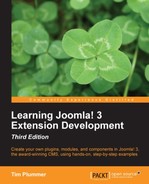This book will give you a step-by-step introduction with practical examples of how to develop plugins, modules, and components for Joomla! 3. It may also be useful for people who wish to make minor modifications to existing components, rather than creating their own extensions from scratch.
Joomla! is one of the world's most popular open source content management systems (CMS), which currently powers approximately 2.7 percent of the websites on the Internet. Joomla! has been downloaded over 35 million times, and has thousands of add-on extensions (apps). Joomla! 3 is the first major CMS to be mobile friendly by default.
Unlike the other two popular open source CMS projects, Joomla! is completely community driven; there is no controlling company or paid staff. Joomla! uses object oriented principles, and is database agnostic. Joomla! is the best mix of functionality, extensibility, and user friendliness.
Developing extensions for Joomla! allows you to harness the full power of Joomla! and build some really great websites and applications. This book is going to give you all the knowledge you need to get started with Joomla! extension development, with lots of practical examples that you can follow along with and learn by doing.
There are many ways that you can get involved with the Joomla! community and contribute to make it better. There is no minimum time commitment; you can contribute as much or as little as you like.
Most major cities have a Joomla! User Group (JUG) that meets regularly to share Joomla! knowledge, which I encourage you to join. Many JUG groups run annual Joomla!Day conferences, which are definitely worth going to, and are a great opportunity to network and pick up some great tips. You can find out about JUG groups and Joomla!Day events at http://events.joomla.org/.
Joining the bug squad is a great way for developers to contribute, and it is also a good place to learn more about the Joomla! codebase and to improve your coding skills. You don't even need to contribute code to be part of the bug squad; you can test other people's patches and make sure they work, and at the same time get a better understanding of how it all works. The Joomla! Developer Network site has links to the issue tracker and other information that will help you get started http://developer.joomla.org/.
Got a few spare minutes? Jump onto the Joomla! forums and answer a few questions; there are many people who are just starting out with Joomla! and could do with a helping hand http://forum.joomla.org/.
Developing extensions is a great way to encourage the use of Joomla! and your individual effort can make a big difference. I know many people who made the decision to use Joomla! due to the availability of just one specific third-party extension that solved the problem they had in an efficient and cost-effective way. So I encourage you to get involved full stop I'm sure you'll have fun along the way and make some new friends at the same time.
Chapter 1, Before you Start, contains some information that you should know before you start developing Joomla! extensions. It will give you a brief introduction to the extension types in Joomla! as well as highlight some new features of Joomla! 3 compared with previous versions. We will also look at licensing, business models, and coding standards, and touch on upgrading Joomla! 2.5 components to Joomla! 3.
Chapter 2, Getting Started with Plugin Development, is where you will create your first plugin for Joomla!. This chapter will introduce some basic concepts such as how the installation XML file works and how to create an installable extension for Joomla!. We will use this plugin later in conjunction with our component.
Chapter 3, Getting Started with Module Development, covers module development, both frontend and backend. We will also look at template overrides and alternative layouts, and how to make your module responsive using Bootstrap.
Chapter 4, Getting Started with Component Development, covers component development and by the end of this chapter you will have built a very simple component that we will make more complex in the following three chapters. It also explores the numerous JForm field types.
Chapter 5, Backend Component Development – Part 1, continues development of our component, but focusing on the backend. Specifically you will learn how to add columns to your view, implement drag and drop ordering, add toolbar buttons and view filters.
Chapter 6, Backend Component Development – Part 2, is where you will finish the backend of your component. You will learn about pagination, submenus, ACL, and how to make your component support multiple database types.
Chapter 7, Frontend Component Development, covers the development of the frontend of your component. You will learn how to add CSS files, menu item parameters, and how to translate your component. We will also look at how your component can interact with other extensions such as Captcha and a third-party comments component.
Chapter 8, Security – Avoiding Common Vulnerabilities, contains some hands-on ethical hacking to teach you about common vulnerabilities and how to avoid them in your extensions.
Chapter 9, Packing Everything Together, covers how you can prepare your extensions for distribution, as well as managing changes. It also shows how you could set up an update server, and some tips for getting listed on the Joomla! Extension Directory.
Chapter 10, Extending your Component with Plugins and Modules, contains a few plugins and modules that extend the functionality of your component, including a smart search plugin. We will also take a look at the new tags feature in Joomla! 3.1 and how you can integrate this into your component.
